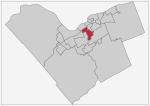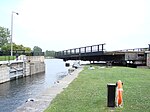St. Elias Antiochian Orthodox Cathedral
1929 establishments in Ontario1992 establishments in Ontario20th-century churches in CanadaCathedrals in OntarioChristian organizations established in 1929 ... and 6 more
Churches completed in 1992Churches in OttawaEastern Orthodox cathedrals in CanadaGreek Orthodox Church of AntiochGreek Orthodox cathedralsLebanese-Canadian culture

St. Elias Antiochian Orthodox Cathedral is an Antiochian Eastern-Orthodox cathedral in Ottawa, Ontario, Canada. It is located at 2975 Riverside Drive just east of Mooney's Bay, south of the Hog's Back Falls. The pastor of the cathedral is Fr. Nektarios Najjar.
Excerpt from the Wikipedia article St. Elias Antiochian Orthodox Cathedral (License: CC BY-SA 3.0, Authors, Images).St. Elias Antiochian Orthodox Cathedral
Riverside Drive, Ottawa
Geographical coordinates (GPS) Address Website External links Nearby Places Show on map
Geographical coordinates (GPS)
| Latitude | Longitude |
|---|---|
| N 45.367197 ° | E -75.688612 ° |
Address
St. Elias Antiochian Orthodox Cathedral
Riverside Drive 2975
K1V 8N5 Ottawa (River)
Ontario, Canada
Open on Google Maps









